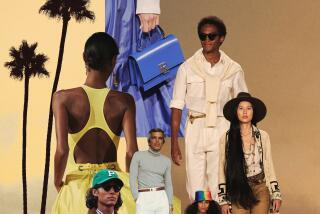FASHION : Women Continue to Shoulder Bold Profile : The foamy garment pads, created in the ‘30s, are more than a design flair. They have become a symbol for female independence.
- Share via
In our midst are hidden persuaders. Born in the ‘30s, they ballooned to huge excesses in the next decade. Then, in a stunning defeat, they appeared to have been wiped from the face of the earth.
But, they were building strength for another onslaught. A generation later, they struck with a vengeance, and the cycle repeated.
Will we ever be free from the influence of the shoulder pad?
There are those who fervently hope not, and cling tenaciously to the mounds of foam. Others see them as a blight on the fashion landscape.
These latter types are unaware of the pads’ true mission, which is not an aesthetic one. Instead, they were created for: intimidation.
Yes, it’s true. When women reach for independence, the womanly silhouette expands with it--in a sort of sartorial muscle flexing.
Consider: When did the first shoulder mushroom out beyond the hip line? When women entered the work force. And, when was the well-documented sequel? Of course, it coincided with the dawn of power dressing in the ‘70s.
It works. Check out the shoulder pad poster woman: Joan Crawford.
The pads were in fact invented for Crawford by her designer at MGM, Adrian. And, if you read her biography, you will see that before she wore them, she was a very shy person. Afterward--well, has there ever been a more intimidating woman than Ms. Crawford?
Which explains why the fad spread so widely. In the ‘40s, women needed to look more or less like quarterbacks to go into industry--their first offensive play.
Then, when robotesque shoulders peaked in the ‘80s, a new generation was in between them, making a statement for full equality.
Having experienced the padded look at least once, women have largely taken sides in what might be called the shoulder pad wars.
“People are passionate about shoulder pads, one way or the other,” said Marie Miller, display manager at Mervyn’s in Ventura.
Some grieve if the additions are left out of a garment; others rip out the smallest padding before taking a purchase home.
Adherents who are noticing less loft in this season’s clothes can find satisfaction anyway--through the portable shoulder pad.
Clingy foam pads can be added to garments that were denied them by a manufacturer. The accessories were pioneered eight years ago by Damin Industries of Burbank, and christened Stay-Put Pads. Millions of them have found their way to women’s shoulders since.
In spite of fashion whims, they remain in demand. “They go up a little bit here, they go down a little bit there; it’s never a big fluctuation,” said Rochelle Rhodes, Damin’s marketing manager. “Women who like their shoulder pads, like ‘em.”
The company grosses over $3 million a year in pads, and offers 10 different models, including its largest, the two-inch wedge, a style we imagine would do Crawford proud.
At the Broadway in Thousand Oaks, we found two Stay-Put models, the one-inch wedge and the one-inch flapped dolman, which features an extension to go under bra straps for complete security.
Both are popular items, said salesclerk Kathryn Carr, who indicated almost all of them are bought by women too young to have experienced the first round of padding in the ‘40s.
Two other retailers confirmed this. Although the look seems to have turned off senior customers for good, many younger women are enamored of the built-up profile.
“I love shoulder pads,” said Miller at Mervyn’s. “I have big hips, and it balances (my figure).”
Another fan of the look, Pat Mages of Thousand Oaks, a child-care worker for Conejo Valley schools, buys pads to add bulk to all of her clothes, including T-shirts.
“They make you look like you’re sitting up straight,” she said, “and they give you a little bit of height.”
Frankly, we took these comments with a grain of salt.
We noticed both women were outgoing, assertive types with challenging careers. They did not avoid confrontation; they stood their ground when asked the sort of odd personal questions most women do not normally face.
And, they had unmistakably larger-than-natural shoulders. It’s a pattern we fashion investigators have seen repeated many times. An imposing profile, a bold stance. It never fails.
We rest our case.






